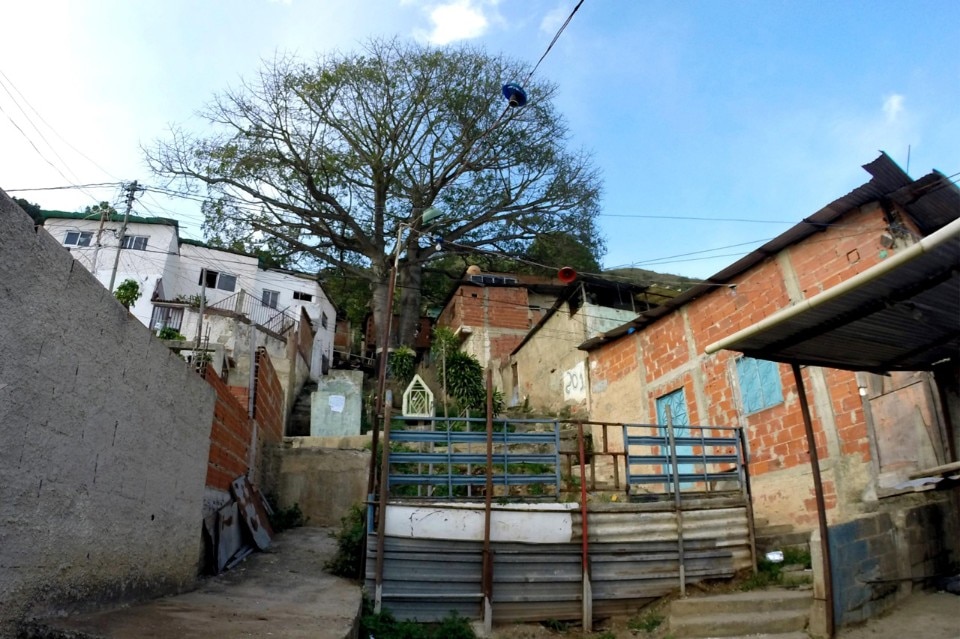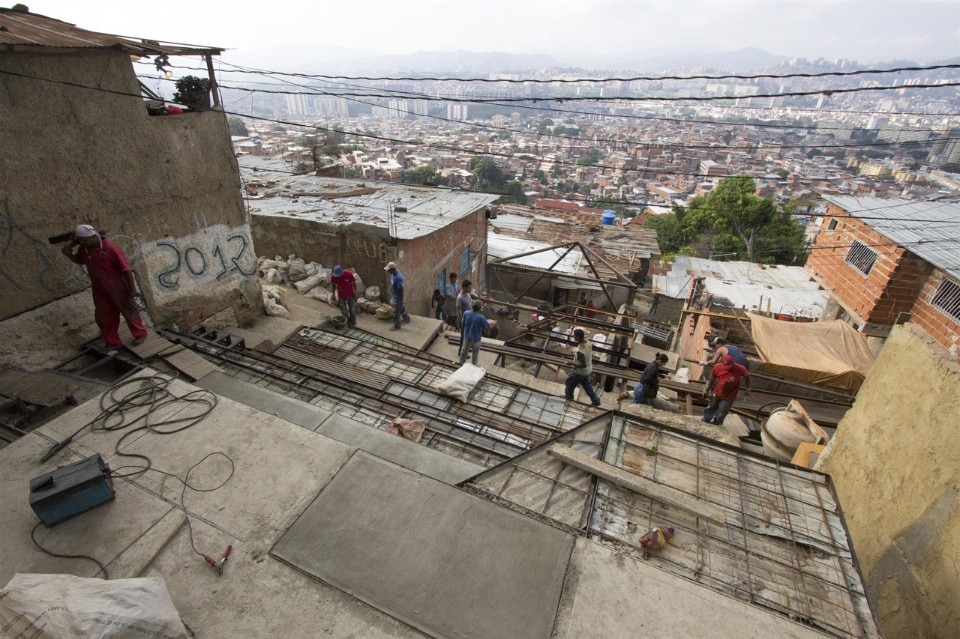Almost 70 years after John F.C. Turner has undertaken one of the first and most radical processes of active critique of the Modern city and “descholarization and reeducation of the architect” through his design actions and studies on informal settlements, processes of rebel urban design challenging the capitalist legacy of the megalopolis era are still propelling new vision on city-making, starting from the scale of local communities.
Through the last ten years, PICO Colectivo (founded by Marcos Coronel and Stevenson Piña) has developed as a young, hybrid reality involved in actions of both public and private space design within the informal urban settlements of Latin America.
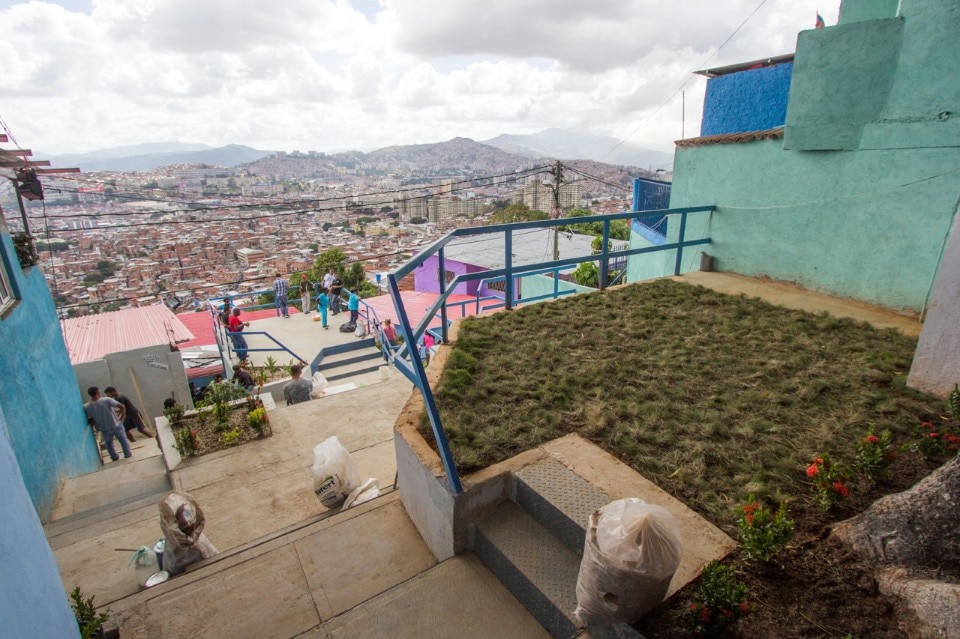
Their most renowned realization has earned global attention as a winner of the Young Architects in Latin America competition in 2018, after three years of gradual development: The Community Facilities System in Los Frailes de Catia (Caracas) was developed by Pico with a larger team, Aparatos Contingentes.
Working on the legitimization of informal settlements by establishing a habitable border within the surrounding Waraira Repano National Park , a restructuration process has taken over the barrio from 2015, promoting the community empowerment through protocols of both social and environmental co-existence activated by spatial tools. The project has created three unconventional multipurpose facilities, breaking several typology clichés: a Reduced Sport Court challenging the competition and high-performance model that stands out in the conventional city, dimensioned to fit its irregular surroundings; an Open Parliament, a circuit of shared neighborhood terraces and tribune assembly in a portion of unoccupied land, 750 square meters in the heart of the neighborhood kept clear by the inhabitants themselves for more than twenty years; a Path Square taking advantage of a stabilization wall built from the permaculture technique to create a workshop-school for training in the management of ecosystems within the neighborhood, including the protection of the National Park.
As the Catia project is reaching its two years of life after completion, we exchanged some words with Marcos Coronel on the contemporary role of such actions, as well as on the current status of rebel and participative city-building practices after years of global research on informal settlements.

In these days of global coronavirus pandemic, the life of the barrios should face radical challenges. How is this emergency affecting the communities? Could you envision any answer to similar changes through design action?
The pandemic threatens to irreversibly damage relations and social kin; still, it paradoxically poses at the same time a real latent opportunity to repair our cities. But not through a topical and superficial treatment aiming to recycle models and returning to the same point where we were: it should be a drastic change forward, towards new physical habitable entities, new territories, flexible and safe spaces that are capable of anticipating, or at least effectively resisting and overcoming aggressive and damaging conditions.
Popular communities are vulnerable spaces but at the same time of cohesion and solidarity. Precisely the favela neighborhoods, which were already the antibody developed by society to immunize themselves against social exclusion and the predation of the territory, can be converted into the genetic code that the city needs to propagate remediation towards future communities and more comprehensive forms of urbanizations, in balance with natural environments around them.

In the vast landscape of design actions for informal settlement, how would you define the peculiarity of your methodology?
Working in the barrio means planning a form of constructed city, still not a formal one. It is about establishing a different paradigm.
New spaces self-built subversively from the need and popular intelligence are governed by a system of flexible relationships, they constitute propitious scenarios were to establish alternative strategies to rethink the model of the city and the ways of building from this set of unprecedented circumstances.
Transformation may come through community forces: in Venezuelan cities, communities can express as a main actor since they have the possibility to meet in community councils and then present their initiatives and requests to public institutions.
Propelling such transformation has nothing to do with an artistic or plainly creative idea of the architect. It’s got to do with a redefinition of time of architecture. This should not be the time of design and construction, it is something larger, starting after all those phases are completed.
You mean you got any control on the aftermath of construction?
We see our profession as a support to a process that goes beyond simple act of providing infrastructure; we want to work more on cultural potential and social relationships within the communities as our building materials.
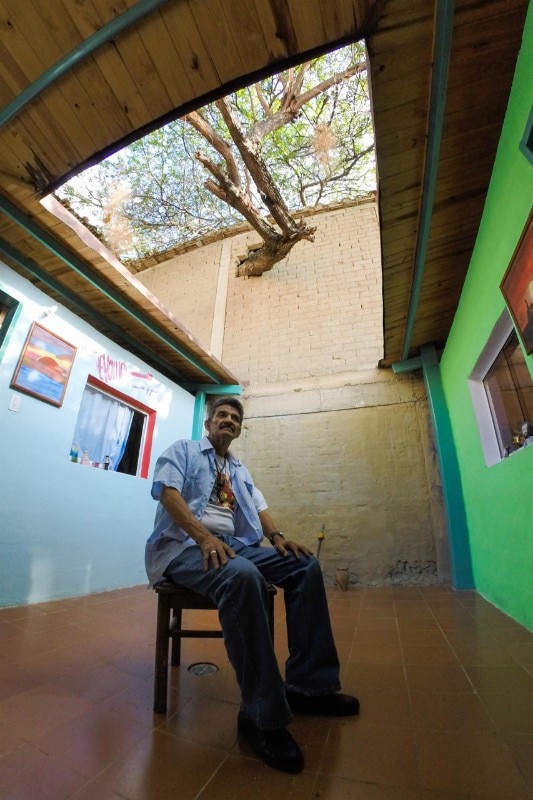
Such actions can therefore set new paradigms concerning the figure of the architect in contemporary context?
In the 70s, the figure of the architect reaching out to the community was a specialist bringing solutions from high above. But communities like those we have worked with have peculiar stories. they began to grow since the 50s, when the formal city started to turn itself into a machinery selling its soul to an artificial dimension.
During the 80s, the heyday of real estate, the barrios in Caracas that opposed the control and the displacement of its inhabitants. tended to protect themselves, closing to outsiders. The conventional figures of architect were someway considered ad belonging to the world of formal.
The first step in trying to develop a different role for the figure of architect is to understand that we are not just architects, but citizens.
There are many different possibilities now to work in cities: architects still act in a limited realm. Few of them are connected to citizenship: they may realize squares, social housing. An even smaller number of architects deals with building citizenship through community centers, houses, playgrounds and so on.Effective interventions should therefore join technical knowledge, popular experience, decision making and all possible forces involved in a real transformation of the barrio environment.
It is quite common to see “final” results and start debating from that point, like “this is the Catia project and this is Pico Colectivo”; the question on “how did all this get to there?” is often overlooked. So: how did you get there?
My first project dates back to 2010. The community I lived in — in the Venezuelan city of Barquisimeto — wanted to develop small housing projects throughout its surface; I was an active member of the community, so I proposed. I decided to be in the community instead of waiting for projects to come, and this way I designed and built a small house close to mine.
Communities just spread the word to one another, so the process keeps growing project after project.
Our collective is some kind of a shapeshifting, sizeshifting office. Right now we are eight people, still we often opened up to different professionals or students, and often worked in networked groups such as the Aparatos Contingentes that were created for the Catia project.
In 2013 we left on a trip through South America and we developed our first actions in many communities of different countries. We were back in Venezuela in 2014 and between 2014 and 2015 started being in charge of design actions within the communities of the city of Caracas.
For such kind of actions Latin America is like some kind of a virgin territory where some kind of an “animal” approach the shaping of space and connections can guide collectivity through radical experiences of transformation. We often ask ourselves ‘Why can we do what we do?’ And we think the answer is related to the complexity of political models we work within, and of those we try to propose: we are immerged in an incredibly experimental context.
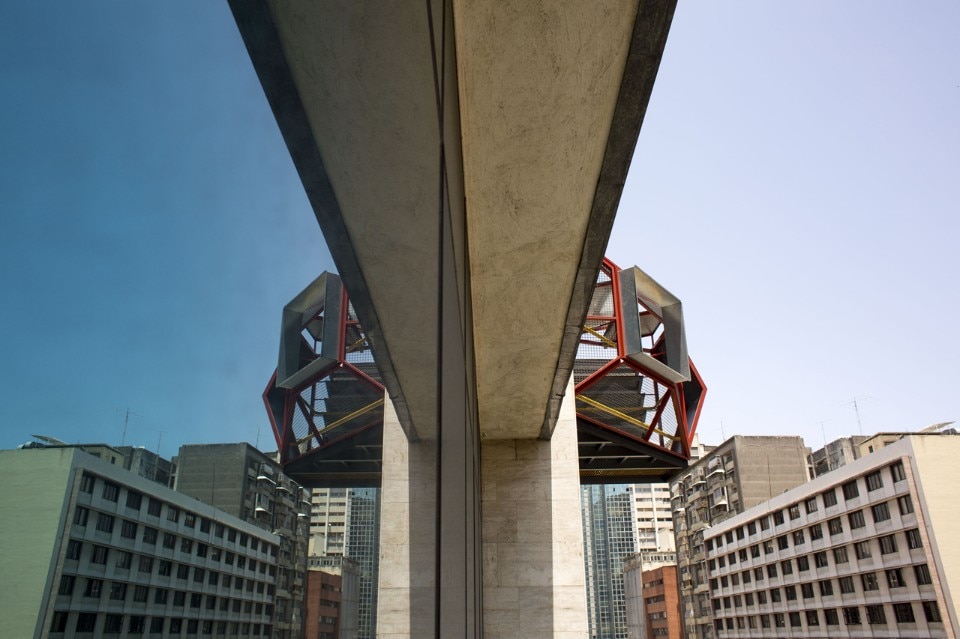
Designing within the informal city is both a theoretical and professional kind of tradition. How do you position about the critique of Modern city that has characterized this tradition since works such as John Turner’s?
These experiences are an opportunity for society to shape and organize a different, non-traditional structure of power autonomously guided by people, by communities themselves: popular power as a fundamental component of political organization. What we try to do is propelling a different view on possibilities to organize society.
Designing for the informal has nonetheless often generated some visual recurrences — some kind of a style someway — and your projects show a recognizable set of apparently intentional formal features. Can one talk about any aesthetic or formal principle in your design practice?
Our process is more mainly made of problem solving, as we get to work in the middle of a network of immediate requirements, receiving the inputs of a non-formal context, building on residual land: each time you have to develop a “local method”, with local skills and intelligence. Each time you start a project therefore you don’t know how it will look like at the end. The Catia projects themselves for instance can be defined as “accident design”.
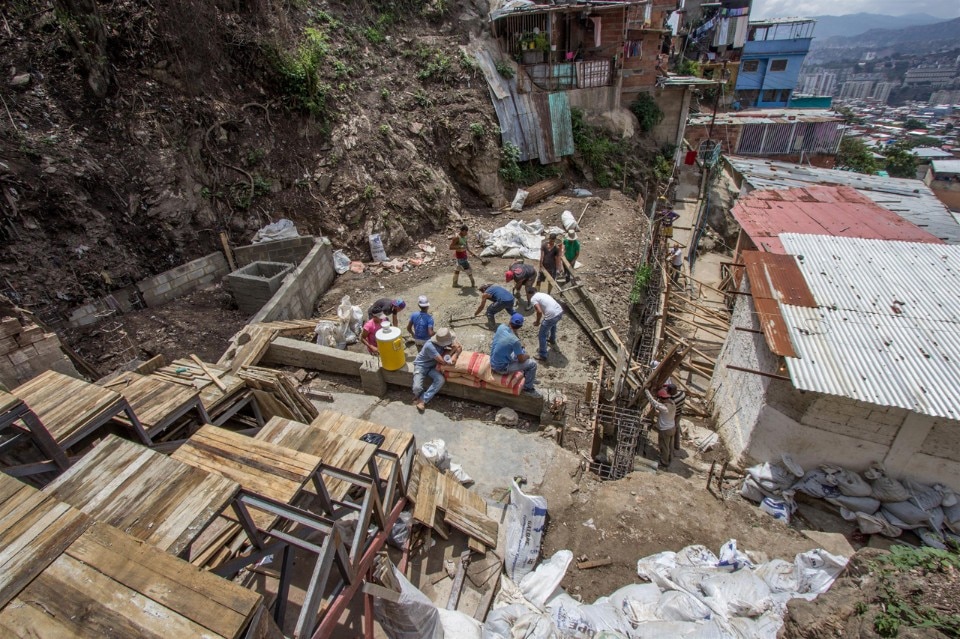
How would you define your position about a broadly debated topic such as participation in design and construction process? Could you see any connection with the previous question?
Sometimes certain projects are designed in situ as the direct interaction with the community becomes intense and crucial. Each community has in any case its own specific requirements and decisional methodologies; still our approach is to oppose standard design processes through immersion in the relational networks of the communities themselves. We also have to consider that usually people do not want to properly design the buildings: they want to give ideas, they want these ideas to get heard and translated into built shapes.
Concerning construction process, most of the times skills and qualified people are found within the community itself, and consequently it’s the community to build its own facilities, to reshape its space, to reshape the city starting from its own forces. We shall not forget that the inhabitants of the barrios are often the very ones that have been employed in the realization of formal city.

- Architects:
- Pico Colectivo
- Project:
- Community Facilities System
- Place:
- Los Frailes de Catia, Caracas, Venezuela
- Years of completion:
- 2015-2019
- Team:
- Aparatos Contingentes : Marcos Coronel, and Stevenson Piña (PICO Colectivo), Gabriel Visconti (Aga estudio), Ricardo Sanz, and Rodrigo Marín.
- Design team :
- María Isabel Ramírez, Ana Cristina Morales, Laura Di Benedetto, Karina Domínguez, José Bastidas, Adriano Pastorino, Joan Martínez, Ruth Mora, Angel Chaparro, Nelyfred Maurera.
- Construction:
- Construction brigades, led by Jesus Fuentes, Danny Arraez, Juan Ortega, Máximo Fonseca, Roger Cólmenarez, Juan Linares










